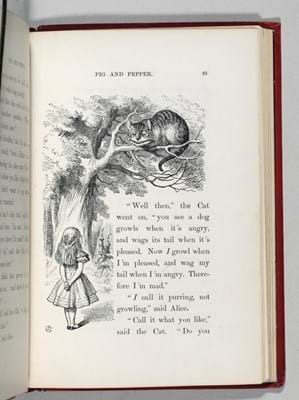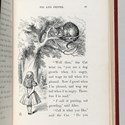Currently available in over 170 languages and dialects and with more in preparation, including copies in Brazilian sign language and Pitjantjatjara, an Australian Aboriginal language, Alice’s Adventures in Wonderland is the most translated English children’s story of them all.
“A language is not complete if there are no translations of the Bible, Shakespeare, and Alice in Wonderland,” said one translator some 50 years ago, and there is never, it seems, any fall-off in demand or shortage of willing translators for the adventures of a literary phenomenon who has been called the ‘Universal Child’.
Adoption of the book by the Surrealists inspired French interest and has so far led to 450 editions in France, while in China, no fewer than 463 editions by some 250 translators have now been produced.
It also continues to fascinate on the big screen – Alice Through The Looking Glass, starring Johnny Depp, a sequel to Tim Burton’s 2010 film Alice in Wonderland, opened on May 27 in the UK.
Where the original English language version is concerned, the very rare 1865 first printing is the ultimate, if almost impossible goal. With only 22 recorded copies, it is rarer than Shakespeare’s First Folio (a copy of which made £1.6m at Christie’s London on May 25) and of those few survivors, 16 are held by institutions* and just six remain in private hands.
Of the latter, just two are in the original cloth – one of which, considered the better example, is estimated at $2-3m in a Christie’s New York sale of June 16.
In 1997 William Self, whose great Dickens library and other classics of English literature were sold in the same rooms in 2007-08, sold this great rarity to another American collector, Jon Lindseth, from whose own catalogue notes the above statistics are all drawn.
A year after acquiring his prize, Lindseth curated an exhibition at New York’s Grolier Club to mark the 100th anniversary of the author’s death, and last year, several US exhibitions were held to commemorate the 150th anniversary of the publication of Alice...
A number of these included loans from Lindseth’s library and his 1865 copy was shown once again at the Grolier Club. At the same time, Alice in a World of Wonderlands: The Translation of Lewis Carroll’s Masterpiece was published. Six years in the making and running to three volumes and over 2500pp, it is thought to be the most extensive analysis ever completed of one English novel.
Today, says Lindseth, all significant Lewis Carroll collections are held by American institutions, so he has decided to leave his own collection to the British Library. However, as the BL already holds a copy of the 1865 Alice..., his copy is to be sold at auction.
Famously illustrated by John Tenniel, the first edition was printed in June 1865, in preparation for publication on July 4, the third anniversary of the river trip on which Carroll had first begun to tell the story to Alice Liddell and her siblings.
Charles Dodgson (who used the pen name of Carroll) asked Macmillan to first bind 50 copies that could be given to and in some instance specially inscribed for friends, but a few days later Tenniel – who, unlike the work’s author, already had an artistic name and reputation to protect – told Dodgson that he was “entirely dissatisfied with the printing of the pictures”.
Alice’s abashed creator agreed that the entire edition of 2000 copies be recalled and even asked those to whom he had already dispatched copies to return them. Thirty-four copies were duly returned and later given away to hospitals and nursing homes.
One of Tenniel’s objections had concerned “show through” of ink that led to text being visible on the reverse side of a sheet, but Dodgson was happy that the rejected sheets be sold and used in the US, where they appeared with a new title page and binding in the 1866 Appleton edition.
In England, Richard Clay reprinted Alice... for Macmillan and this first authorised edition appeared in December 1865, though it is dated 1866 in the imprint.
The Lindseth copy was that originally given to George W Kitchin, one of Dodgson’s colleagues at Oxford and the secretary of the School Book Committee for the OUP, who later gave it to his daughter, Alexandra, or ‘Xie’, one of Carroll’s favourite photographic models.
In 1925 Xie put her copy up for auction – but died on the very day of the sale. Acquired by Dr Rosenbach, the celebrated Philadelphia book dealer, for the Pforzheimer Library, it was 50 years later sold to another collector, Harriet Borland. Only a couple of years later her library too was sold and it was bought on that occasion by the bibliophile and Los Angeles film and TV producer, ‘Bill’ Self, whose many credits include the transfer of MASH from the big screen to a hugely successful, long-running TV series.
* Of those 16, a presentation copy at Dodgson’s own Oxford college, Christ Church, has not been seen since the 1920s.
The regular first Alice
In a Swann sale of May 18 a lot offering regular first issue copies in original cloth of both Alice... (1866) and Through the Looking Glass (1872), each inscribed by the author to Bessie Slatter, sold at $40,000 (£27,400).
Bessie, or Elizabeth as she is styled in the later inscription, was the daughter of a close friend and cleric, John Slatter, and another of Dodgson’s young photographic models.
Offered in a Bloomsbury Auctions sale of May 26 was a copy in a red morocco gilt pictorial binding by Bayntun Rivière of The Nursery ‘Alice’ of 1889. This was a simplified version aimed at very young children, employing a bigger typeface and enlarged and coloured, and as well as a Christmas gift presentation inscription, this copy contained other autograph notes and a postcard from Dodgson to the printer, Edmund Evans, plus copies of his Wonderland Postage Stamp Case and Eight or Nine Wise Words. It was valued at £25,000-35,000 but failed to sell.









